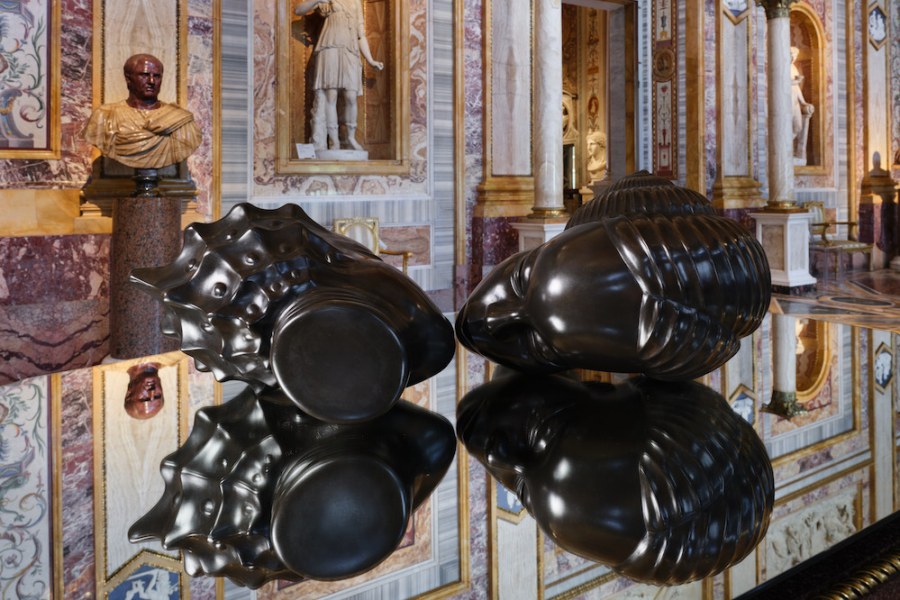From the July/August 2025 issue of Apollo. Preview and subscribe here.
Wangechi Mutu’s Underground Hornship (2018) rests on an extravagant 18th-century table, on to which the Kenyan-American artist has placed a mirror. It is not possible to see her sculpture – a gnarled bronze that is part tree root, part horned creature – denuded of the opulence surrounding it. Mutu is that rare bird, a living artist invited to exhibit at the Galleria Borghese in Rome, a collection of Roman, Renaissance and baroque art housed in a pleasure palace for which the word ‘lavish’ falls piteously short.
In the Borghese’s Room of the Emperors the walls are patterned with porphyry and alabaster, against which stand 14 matching ‘Roman’ busts. Its centrepiece is Bernini’s explosive Rape of Proserpine (1621–22), a miracle of marble made flesh in which the young goddess struggles to free herself from the bruising grip of Pluto as Cerberus snarls behind her flailing feet. Here sits Underground Hornship on its mirrored base, in which all the decorative aspects of the upper room appear reflected. These include scenes from Ovid’s Metamorphoses in frescoes by Domenico de Angelis and a string of dung-like beads the size of cannonballs – Mutu’s Prayers (2020) – suspended from the ceiling.
Positioning contemporary artworks in any highly decorated and historically charged space is not straightforward: already there is nowhere for the eye to rest, no aesthetic pause. How to navigate this to accommodate work in a different formal register? Mutu’s response has been to claim space that might otherwise be occupied by the bodies of visitors, positioning some works directly on the floor. Some step up to the grandeur and pomp of the building and its collection. The Seated I and IV (both 2019) are installed at the entrance of the palace. First commissioned for the Metropolitan Museum of Art, here they flank the doorway like caryatids with a defiant oracular attitude. Monumental bronze figures, their bodies are adorned with lip plates and neck rings as well as sculptural flourishes gleaned from various East and Central African traditions.
Seated I (2019), Wangechi Mutu. Metropolitan Museum of Art, New York. Photo: Joseph Coscia Jr.; courtesy the artist/Gladstone Gallery; © the artist
With other installations, Mutu dramatically subverts the Borghese. Suspended Playtime (2008) fills the central part of an upper gallery. A forest of balls hanging from coloured streamers, it is perfectly scaled to the space but formed from materials (notably plastic bags) that speak of another world – of cheapness and disposability, of children and improvised toys. Other works incorporate found materials such as fragrant coffee grounds, pungent earth and fabric taken from her late parents’ curtains.
Bereavement ripples from First and Second Weeping Head (both 2025). Their faces have the aspect of forms emerging from the gnarled wood that sits caked beneath a layer of red soil. Sparkling beads dangle across their faces like tears. Mutu has cloaked the window behind them reverentially with thin yellow cloth and within this lowered light they share human space and scale, hanging from the ceiling without the presentational formality of a plinth.
Is there any exhibition space that allows art to be seen without context? Much as it might pretend to be neutral, a white cube gallery in New York is anything but. Rather than acceding to cohabitation without comment, the exhibition is marked by a sense both of belonging (the work has ‘earned’ the right to be here) and of being from another place. These are invited guests, but guests they remain. Many of Mutu’s sculptures are otherworldly in aspect: mythic, humanoid, or more-than-human. The infant Noah appears in his monumental basket (Musa, 2021), his extravagant lashes fluttering over the large eyes of his alien head, his long fish tail dangling down the side. Perhaps this child of exiles has adapted so that he no longer needs rescuing from the alien waters of the Nile?
Installation view of Wangechi Mutu’s ‘Black Soil Poems’ at Galleria Borghese, Rome, in 2025. Photo: © Galleria Borghese; © Wangechi Mutu
Context has forced its way into this exhibition from beyond the gallery walls. Mutu’s show opened in Rome the day an Italian referendum designed to ease citizenship rules was derailed by politicians (including far-right prime minister Giorgia Meloni) who encouraged a boycott. The referendum, which had been initiated by a citizens’ initiative and supported by trade unions, was a means to offer better rights to workers with roots outside of Italy. At the heart of the call to boycott the referendum was the question of Italy’s self-image, one that is entwined with cultural patrimony and an enchanted vision of the past. In a sense, the context that led to the failed referendum was already within the gallery walls: despite the pan-Mediterranean reach of the actual Roman empire, the historical fantasy of Rome on display in the Borghese collection is one populated by figures that are white and European.
Mutu’s work speaks not to purity but mixture, pulling together diverse myths and traditions to construct her own blended pantheon. In this interest in hybrid bodies, her works find curious kinship with Bernini, who sculpts the infant Zeus suckling milk from his adoptive mother Amalthea (who happens to be a goat), and the body of the nymph Daphne in the early stages of transformation into a bay tree. The roots that sprout from Daphne’s toes and shoots of laurel that emerge from her fingers sprout too from Mutu’s First and Second Weeping Head (both 2025). Through using mirrored surfaces and architectural interventions to direct attention to the intense context in which her work is shown, Mutu refuses to set herself apart, instead pulling everything together into an enriched field of reference.
From the July/August 2025 issue of Apollo. Preview and subscribe here.
